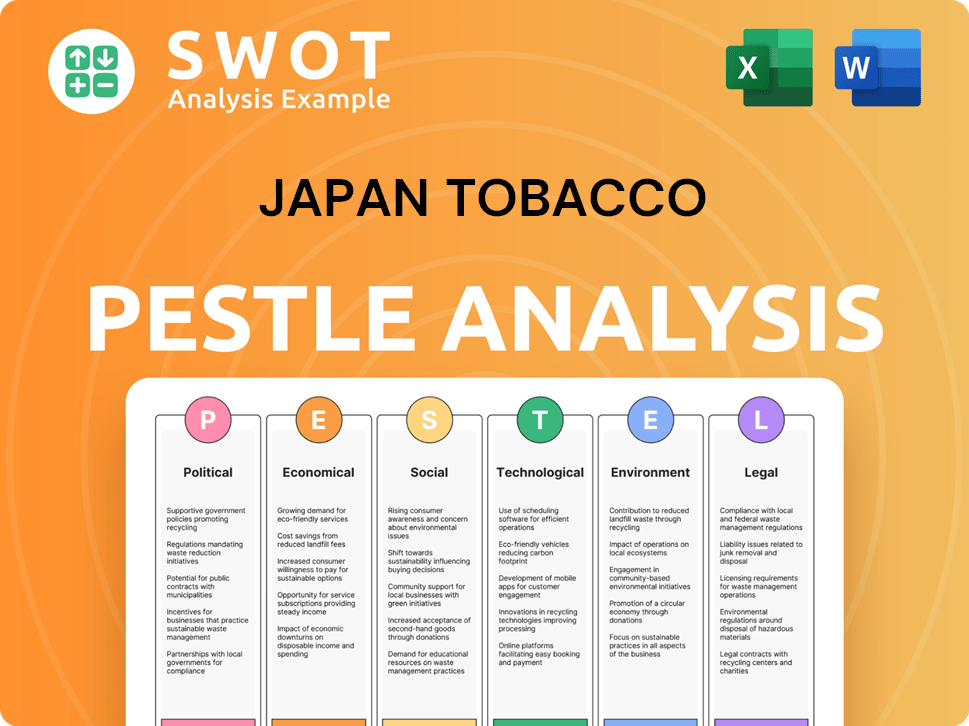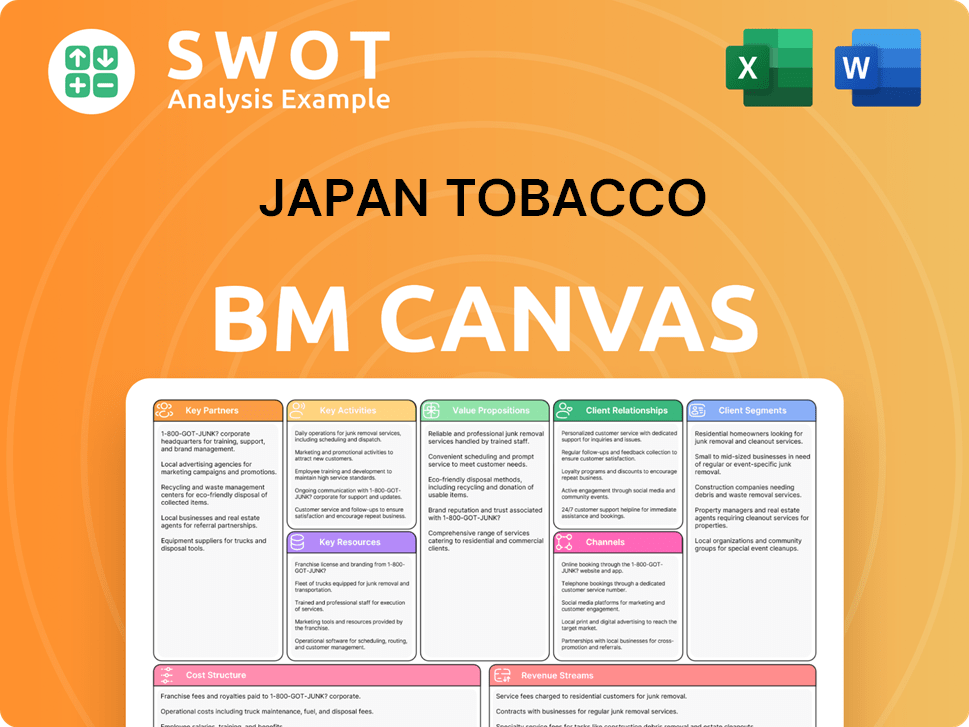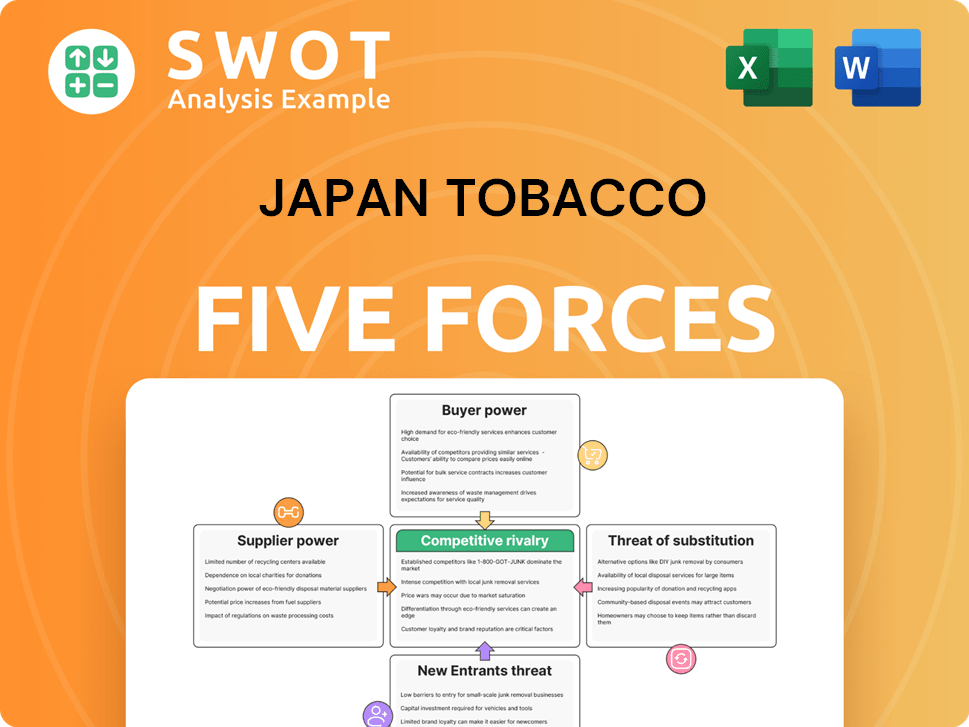Japan Tobacco Bundle
Who Buys Japan Tobacco Company Products?
In the dynamic world of tobacco, understanding Japan Tobacco SWOT Analysis is crucial for success. JT Group's ability to adapt hinges on a deep understanding of its customer demographics and target market. This exploration delves into the evolving consumer profile, moving beyond traditional smokers to encompass a global audience.

This analysis provides a comprehensive market analysis of Japan Tobacco Company, revealing insights into consumer behavior and product preferences. We'll examine JT's target audience demographics, including age range and gender distribution, while also investigating the company's marketing strategies across different regions. Furthermore, we'll explore how JT defines its target market and adapts to changing smoking habits in Japan and beyond, ensuring a relevant and data-driven perspective on JT's consumer base.
Who Are Japan Tobacco’s Main Customers?
The primary customer segments for Japan Tobacco Company (JTC) are evolving, reflecting global shifts in consumer preferences and the company's strategic focus on reduced-risk products. While traditional adult smokers remain a key segment, particularly in markets where combustible cigarette consumption is still significant, JTC is actively targeting adult consumers seeking alternatives to traditional cigarettes. This includes individuals transitioning to heated tobacco products (HTPs) like Ploom and oral tobacco products.
Geographically, JTC's customer base is global, with significant segments in Japan, Western Europe, and emerging markets. In Japan, despite a declining overall smoking rate, the adoption of HTPs has been notable, indicating a segment of adult smokers willing to switch to alternative nicotine delivery systems. In Western Europe, while combustible cigarette sales face pressures, JTC's focus on brand strength and portfolio diversification caters to existing adult smokers and those exploring alternatives. Emerging markets often represent younger demographic profiles with potential for growth in both traditional and alternative tobacco products, though specific age and income demographics vary widely by region.
The company primarily serves consumers (B2C). JTC's continuous market research and product development initiatives, such as the introduction of new Ploom devices, are driven by shifts in consumer preferences and regulatory landscapes, prompting a strategic pivot towards these evolving segments. For a deeper dive into JTC's strategic direction, consider reading about the Growth Strategy of Japan Tobacco.
This segment includes adult consumers who continue to purchase and consume combustible cigarettes. This is a core segment for JTC, particularly in markets where traditional cigarette consumption remains high. The company focuses on maintaining brand loyalty and market share within this segment through product innovation and marketing strategies.
This segment comprises adult consumers who have switched from traditional cigarettes to HTPs, such as the Ploom devices. JTC is actively targeting this segment with product development and marketing efforts. The growth in this segment is a key indicator of JTC's success in the reduced-risk products market.
This segment includes adult consumers who use oral tobacco products. JTC is expanding its product portfolio to cater to this segment. The company aims to capture a share of the growing market for alternative nicotine delivery systems.
This segment is located in emerging markets. These markets often have younger demographic profiles with the potential for growth in both traditional and alternative tobacco products. JTC tailors its product offerings and marketing strategies to suit the specific needs and preferences of consumers in these regions.
The customer demographics for JTC vary by region, with key differences in age, income, and smoking habits. Market analysis indicates a shift towards reduced-risk products, particularly in developed markets. JTC's marketing strategies are tailored to target specific demographics and consumer behaviors.
- Age Range: Varies by market; typically targeting adults aged 18 and over.
- Gender Distribution: Varies, but generally skewed towards males in traditional cigarette consumption.
- Geographic Focus: Japan, Western Europe, and emerging markets are key areas.
- Product Preferences: Increasing demand for HTPs and other reduced-risk products.
- Consumer Behavior: Influenced by regulatory changes, health concerns, and product availability.
Japan Tobacco SWOT Analysis
- Complete SWOT Breakdown
- Fully Customizable
- Editable in Excel & Word
- Professional Formatting
- Investor-Ready Format

What Do Japan Tobacco’s Customers Want?
Customer needs and preferences for Japan Tobacco Company (JT) products are evolving, moving beyond traditional nicotine consumption to encompass a broader range of factors. Consumers now consider harm reduction, convenience, and sensory experiences. This shift is driving demand for alternatives like Heated Tobacco Products (HTPs) and oral tobacco, which appeal to those seeking reduced health risks and less intrusive experiences.
Traditional cigarette users still value brand loyalty, taste, and established rituals. However, a growing segment prioritizes alternatives with perceived lower health risks, reduced odor, and social acceptability. The company's product development and marketing strategies reflect these changing preferences.
JT continually innovates its product portfolio, responding to consumer demand for advanced HTP technology. They tailor marketing messages to highlight the benefits of HTPs, such as reduced smell and ash, and offer diverse flavors for both traditional and alternative products. This approach aims to address pain points like the social stigma associated with smoking.
Customers are increasingly driven by the desire for reduced-risk alternatives. This leads to increased demand for HTPs and oral tobacco. These consumers prioritize factors such as perceived lower health risks, less intrusive odor, and social acceptability.
JT addresses evolving preferences by continually innovating its product portfolio. The Ploom X Advanced, launched in October 2024, is an example of this. This product addresses preferences for an enhanced heating experience and improved taste.
Purchasing behaviors are influenced by product accessibility, price, and regulatory environments. In markets with stringent smoking regulations, consumers may seek discreet or less odor-producing alternatives. Decision-making criteria for HTP users often include device aesthetics and battery life.
JT tailors marketing messages to highlight specific benefits of HTPs, such as reduced smell and ash. The company also focuses on addressing pain points like the social stigma of smoking by promoting less intrusive alternatives.
Customer feedback and market trends are integral to JT's product development cycle. This leads to the refinement of existing products and the introduction of new ones. These actions align with the changing landscape of adult nicotine consumption.
A significant portion of JT's customer base is motivated by the desire for reduced-risk alternatives. This is a key driver for the adoption of HTPs and oral tobacco products. These products are designed to offer a potentially less harmful experience.
Understanding the consumer profile is crucial for Japan Tobacco Company. The company's approach to the market involves several key elements:
- Product Development: JT focuses on innovation, as seen with the Ploom X Advanced.
- Marketing: Tailoring messages to highlight specific benefits of HTPs and addressing consumer pain points.
- Customer Feedback: Using feedback and market trends to refine existing products and introduce new ones.
- Regulatory Environment: Adapting to stringent smoking regulations by offering discreet alternatives.
Japan Tobacco PESTLE Analysis
- Covers All 6 PESTLE Categories
- No Research Needed – Save Hours of Work
- Built by Experts, Trusted by Consultants
- Instant Download, Ready to Use
- 100% Editable, Fully Customizable

Where does Japan Tobacco operate?
The geographical market presence of Japan Tobacco Company (JT) is extensive, encompassing key regions across Asia, Europe, and emerging markets. Japan, as the company's home base, remains a critical market, contributing significantly to revenue, especially with the increasing adoption of heated tobacco products. JT maintains a strong market share and brand recognition in Japan, with well-established brands like Cabin and Seven Stars.
In Europe, JT has a robust presence, particularly in Western Europe, holding strong market positions with brands such as Winston and Camel. The company also focuses on growth opportunities in Eastern Europe and CIS countries. The company strategically tailors its offerings and marketing strategies to suit regional differences, adjusting product formulations, packaging, and promotional campaigns to resonate with local consumers.
JT's geographic distribution of sales reflects a balanced portfolio, with significant contributions from both mature and developing markets, supporting its global diversification strategy. This approach allows the company to navigate varying regulatory landscapes and consumer habits effectively. For a deeper understanding of the company's marketing approach, consider exploring the Marketing Strategy of Japan Tobacco.
JT has a strong presence in several Asian countries, including Japan, which is a crucial market. The company focuses on expanding its heated tobacco product (HTP) offerings in this region. Market analysis indicates varying consumer preferences and regulatory environments across different Asian countries, influencing JT's product strategies.
Europe is a significant market for JT, with a strong presence in Western Europe and growth initiatives in Eastern Europe and CIS countries. Consumer demographics, preferences, and purchasing power vary across these regions. JT adapts its product formulations and marketing campaigns to resonate with local consumers in each country.
JT strategically targets emerging markets to capitalize on growth opportunities. These markets often present different challenges and opportunities compared to established markets. The company tailors its product offerings and marketing approaches to suit the specific needs and preferences of consumers in these regions.
JT emphasizes product localization to meet the specific demands of each market. This involves adapting product formulations, packaging, and promotional campaigns to resonate with local consumers. The company's approach is crucial for maintaining a competitive edge in diverse markets.
Japan Tobacco Business Model Canvas
- Complete 9-Block Business Model Canvas
- Effortlessly Communicate Your Business Strategy
- Investor-Ready BMC Format
- 100% Editable and Customizable
- Clear and Structured Layout

How Does Japan Tobacco Win & Keep Customers?
The Japan Tobacco Company (JT) focuses on acquiring and retaining customers through a multi-pronged strategy. This includes adapting to the evolving tobacco market, especially with the rise of reduced-risk products. The goal is to maintain and grow its customer base while navigating regulatory pressures and changing consumer preferences. JT's approach is crucial in a dynamic industry.
For traditional tobacco products, JT utilizes point-of-sale advertising and brand visibility in retail outlets. However, with the shift towards reduced-risk products, JT is increasingly leveraging digital channels and direct-to-consumer platforms. This is particularly evident with its Heated Tobacco Products (HTPs) like Ploom, where they focus on educating adult consumers about the benefits of switching from traditional cigarettes.
Customer retention is a key focus, especially in the declining combustible market. JT is exploring loyalty programs and personalized experiences, such as tailored product recommendations for HTP devices. Customer data and CRM systems play a critical role in segmenting adult consumers and delivering targeted campaigns. Continuous product innovation, like the launch of Ploom X Advanced in October 2024, also helps to acquire new users and retain existing ones.
Traditional marketing channels, like point-of-sale advertising, remain relevant for combustible tobacco products. These are crucial for maintaining brand visibility in retail environments. JT ensures its products are prominently displayed in stores to capture consumer attention.
JT is increasing its focus on digital channels, social media, and direct-to-consumer platforms for HTPs. This allows for more targeted campaigns and engagement with adult consumers. Digital marketing enables JT to provide detailed information about products like Ploom.
Experiential marketing is used to educate consumers about the benefits of switching to HTPs. This often involves in-person events and demonstrations. JT aims to provide hands-on experiences to showcase the advantages of reduced-risk products.
JT is exploring loyalty programs for HTPs to encourage repeat purchases and brand loyalty. Personalized experiences, such as tailored product recommendations based on usage patterns, are also being implemented to enhance customer engagement. These programs aim to make customers feel valued.
Customer Relationship Management (CRM) systems are becoming increasingly critical for segmenting adult consumers. JT uses these systems to deliver targeted campaigns that resonate with preferences for taste, device features, and nicotine delivery. This data-driven approach allows for more effective marketing.
- JT utilizes CRM systems to understand consumer behavior.
- Data analysis helps tailor marketing messages.
- Personalized recommendations improve customer engagement.
- Campaigns are designed based on consumer preferences.
Product innovation, such as the launch of Ploom X Advanced in October 2024, is key to acquiring new users and retaining existing ones. JT continuously updates its product line to offer enhanced experiences. This focus on innovation helps maintain customer loyalty and market share. For more insights, check out the Revenue Streams & Business Model of Japan Tobacco.
- New product launches enhance customer experience.
- Advanced features attract new users.
- Continuous improvement fosters customer loyalty.
- Innovation helps JT stay competitive.
Japan Tobacco Porter's Five Forces Analysis
- Covers All 5 Competitive Forces in Detail
- Structured for Consultants, Students, and Founders
- 100% Editable in Microsoft Word & Excel
- Instant Digital Download – Use Immediately
- Compatible with Mac & PC – Fully Unlocked

Related Blogs
- What are Mission Vision & Core Values of Japan Tobacco Company?
- What is Competitive Landscape of Japan Tobacco Company?
- What is Growth Strategy and Future Prospects of Japan Tobacco Company?
- How Does Japan Tobacco Company Work?
- What is Sales and Marketing Strategy of Japan Tobacco Company?
- What is Brief History of Japan Tobacco Company?
- Who Owns Japan Tobacco Company?
Disclaimer
All information, articles, and product details provided on this website are for general informational and educational purposes only. We do not claim any ownership over, nor do we intend to infringe upon, any trademarks, copyrights, logos, brand names, or other intellectual property mentioned or depicted on this site. Such intellectual property remains the property of its respective owners, and any references here are made solely for identification or informational purposes, without implying any affiliation, endorsement, or partnership.
We make no representations or warranties, express or implied, regarding the accuracy, completeness, or suitability of any content or products presented. Nothing on this website should be construed as legal, tax, investment, financial, medical, or other professional advice. In addition, no part of this site—including articles or product references—constitutes a solicitation, recommendation, endorsement, advertisement, or offer to buy or sell any securities, franchises, or other financial instruments, particularly in jurisdictions where such activity would be unlawful.
All content is of a general nature and may not address the specific circumstances of any individual or entity. It is not a substitute for professional advice or services. Any actions you take based on the information provided here are strictly at your own risk. You accept full responsibility for any decisions or outcomes arising from your use of this website and agree to release us from any liability in connection with your use of, or reliance upon, the content or products found herein.